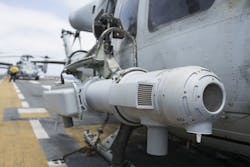Navy and Marine Corps pick Toyon Research to provide aircraft electronic warfare (EW) and embedded computing
RIDGECREST, Calif. – Airborne electronic warfare (EW) experts at Toyon Research Corp. in Goleta, Calif., will provide the U.S. Navy and Marine Corps with EW capability for fixed-wing aircraft, helicopters, and unmanned aerial vehicles (UAVs) under terms of an $11.7 million five-year contract announced last week.
Officials of the The Naval Air Warfare Center Weapons Division at China Lake Naval Weapons Station in Ridgecrest, Calif., are asking Toyon Research to provide AN/ALQ-231(V) Intrepid Tiger (IT II) family of systems production hardware and engineering support.
The Intrepid Tiger II EW pod and embedded computing subsystem provides airborne electronic warfare and electronic attack communications jamming capability for Navy and Marine Corps fixed-wing aircraft, helicopters, UAVs, ground-based systems, and laboratories.
The contract calls for Toyon Research to provide 24 (V) 4 maintenance stands; 18 (V) 4 radio frequency (RF) coupler sets (aft); 18 (V) 4 RF coupler sets (forward); seven IT II V3 direction finding array RF coupler sets; and seven IT II V3 RF couplers.
Related: Enabling technologies for airborne electronic warfare
In 2012 Navy officials designated the AN/ALQ-231(V) Intrepid Tiger II as a rapid deployment capability to provide critical aircraft electronic attack capability to ground forces, Navy officials say.
General Micro Systems Inc. (GMS) in Rancho Cucamonga, Calif., provides the company's S902R Golden-Eye III and S905R Raider III rugged processor and data storage systems for the AN/ALQ-231(V).
GMS is the original source of the system's rugged general-purpose processors, and is the only company that can provide processors and components without a substantial duplication of cost to the government, Navy officials say.
The GMS Golden-Eye III is designed to provide rugged embedded computing for defense and UAV applications, as well as industrial and commercial applications, GMS officials say. It is widely deployed in Army vehicles, robots, and UAVs, and works with the Windows 7, Linux, and VxWorks operating systems.
Related: Rugged embedded computing chassis introduced by LCR
The S902R Golden-Eye III small lightweight computer is conduction cooled and sealed, and operates in temperatures from -40 to 85 degrees Celsius without throttling, GMS officials say. The computer is based on the Intel i7 Core processor with as many as four physical CPU cores, as much as 16 gigabytes of SDRAM.
The S902R supports as many as five Gigabit Ethernet channels with TCP/IP offloading engine, six USB 2.0 ports, as many as four removable 2.5-inch solid-state drives, eight buffered digital I/O lines, dual video, four COM ports with RS232/422/485 options, and an audio headset jack with a one-watt audio amplifier to drive an 8-ohm speaker.
The Golden-Eye computer measures 5.38 by 6.88 by 2.13 inches, weighs 3.25 pounds, and consumes as little as 25 Watts of power.
The GMS S905R Raider III also is a rugged computer for defense and UAV applications that is designed for applications where a rugged computer is needed to provide the best possible performance per dollar per Watt, GMS officials say.
The Raider III supports the Intel i7 Core processor,and runs on the CANbus and MIL-STD-1553 databuses. Like its Golden-Eye cousin, it operates in temperatures from -40 to 85 C. It is a fanless system that can be mounted directly to a metal surface or be used as a stand-alone system. It measures 5.5 by 5.5 by 1.24 inches, weighs 1.9 pounds, and runs on as little as 25 Watts of power.
Toyon Research specializes in technology development and defense systems analysis, with a focus on antennas and RF systems; aerospace systems; RF products; ISR algorithms; homeland security; and autonomous systems.
On this contract Toyon Research will do the work in Goleta, Point Mugu, and China Lake, Calif.; and Yuma, Ariz., and should be finished by March 2027.
For more information contact Toyon Research Technologies online at www.toyon.com; General Micro Systems at www.gms4sbc.com, or the Naval Air Warfare Center Weapons Division at www.navair.navy.mil/nawcwd.
About the Author
John Keller
Editor-in-Chief
John Keller is the Editor-in-Chief, Military & Aerospace Electronics Magazine--provides extensive coverage and analysis of enabling electronics and optoelectronic technologies in military, space and commercial aviation applications. John has been a member of the Military & Aerospace Electronics staff since 1989 and chief editor since 1995.
